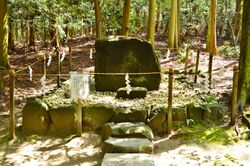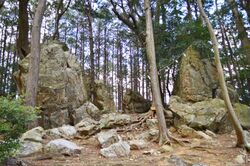Iwakura (Yorishiro)
Topic: Religion
 From HandWiki - Reading time: 3 min
From HandWiki - Reading time: 3 min
Iwakura refers to the belief in rocks as Yorishiro containing Kami in ancient Shintoism, or the rocks themselves as the object of belief.
Overview
Nature worship (spirit worship, animism), which has existed in Japan since ancient times, is a type of base faith. In Shinto rituals, God descended from a God, a rock, and made his Yorishiro (called Himorogi) and divine power the center of the ritual. As time went on and temples, where gods were believed to be always present, became more permanent, the object of worship moved away from the body of the god and toward the shrine itself. In many cases, sacred trees and sacred stones adorned with shimenawa ropes still exist in their precincts.
In addition to rock, other examples of belief in nature include the Chinju no Mori (ja) ("Mori" itself refers to the shrine, and the forest is the forest itself), the "island" as an forbidden area, the Munakata Taisha's Okinoshima of Munakata Taisha, belief in "mountains" such as Rokko Himei Shrine and Mount Miwa, belief in "fire", Waterfall, and a wide range of weather phenomena such as wind, rain, and Lightning. It is a weather phenomenon.
It is said that there is another rock-related object, Iwasaka, which is a ritual site centered on a rock, but there is no actual example of this in comparison to Iwaza. However, in this case, there are no actual examples of such a site. The "Nihonshoki" (Chronicles of Japan) distinguishes Iwasaka from Iwaza, so it is something different from Iwasaka. In other words, a banjiki is the same as a stone circle, which is an ancient ruin made of stones arranged in a ring, and is a ritual ruin that shows the "divine realm" by artificially assembling boundary stones to form a boundary to preserve it as a sacred and clean place.
Nowadays, trees and forests such as sacred trees and broad-leaved evergreen trees such as sakaki, which are used as Yorishiro in rituals, are called HIMON-belief or HIMON-za, while mountains, stones, and rocks are called BANZA when they are used as Yorishiro.
Some of the megaliths along the Kaido have Buddhism carved on them, and some have Legends attached to them, such as the famous samurai who connected Horses. There is a research group (Iwakura Gakkai) that claims that the belief in rock formations and megaliths, including these, can be traced back to the Jōmon period, and that there are also artificially arranged rock formations, and that their arrangement represents certain figures, directions, or the shape of the Constellation. In contrast to this view, the Iwakura Society points out that it was not until the Kofun period that the Iwakura ritual began.[1] and criticism of the theory that megaliths are artifacts.[2]。
Gallery
See also
- Shrine
- Shinto shrine
- Shrine (Yashiro) (ja)
- Kannabi (ja)
- Kamagoishi
- Himorogi
- Utaki
- Megalith
- The four supreme deities (ja)
- Fujizuka
- Okinoshima
- Crystal healing
- Cinnabar
References
- ↑ Tsutomu Tokieda, Archaeological Study of Mountain Sacred Sites, Yusankaku Inc. 2018
- ↑ "Archived copy". http://www.mars.dti.ne.jp/~techno/column/asizuri.htm.
External links
 KSF
KSF




